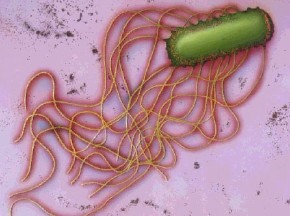|
At least one common disease-causing microbe
becomes more virulent in simulated microgravity. Scientists studying
this phenomenon hope to gain a better understanding of infectious
disease.
by Patrick L. Barry
Life is a bit different
in space, even for microbes. Research shows that the pattern of
gene activity in some microbes differs in weightlessness, leading
to differences in behavior. These differences could be behind a
curious observation: the common food-borne pathogen salmonella becomes
more virulent when grown in a form of simulated microgravity.
This news is little
comfort to astronauts whose immune systems already function below
par in weightlessness, making infection more likely. To help keep
astronauts healthy and to better understand microbial infection
in general, scientists want to know exactly which genes are affected
by microgravity and why weightlessness - whether real or simulated
- should cause these changes.
"Whenever you see the
virulence of a microbe change in response to an environmental stimulus,
that's a chance to learn something about how that pathogen causes
disease," says Cheryl Nickerson, an expert in microbiology and immunology
at Tulane University Health Sciences Center.

Image courtesy Avinash
Abhyankar
A false-color
micrograph of the disease-causing microbe salmonella
|
Nickerson and her colleagues
hope that studying these changes could point out new ways to combat
"bad" microbes with drugs and vaccines, both for the sake of astronauts
and for people here on the ground. Using modern advances in biotechnology
and the weightlessness provided by the International Space Station
(ISS), they plan to explore the changes in gene expression experienced
by microbes in the true weightlessness of spaceflight.
Their first experiment, called "Yeast GAP", will send genetically
engineered brewer's yeast (Saccharomyces cerevisiae)
up to the space station aboard a Russian Progress rocket in 2004.

Image courtesy David Byres,
Florida Community College at Jacksonville
The single-celled
fungus Saccharomyces cerevisiae, also known as brewer's
yeast.
|
Brewer's yeast itself
is not pathogenic. Nevertheless, "yeast cells make a great 'model
organism' for this research because they're easily handled, thoroughly
studied, and their genome has been completely mapped," says Nickerson,
the principal investigator of Yeast GAP. Furthermore, brewer's yeast
shares much of its DNA with infectious species of microscopic fungi
and protozoans. "Also, the yeast's genome is relatively simple,
which makes the results easier to analyze," she says.
Still, the challenge
is formidable. The brewer's yeast genome contains 6,312 genes, each
of which produces one of the proteins that constitute the molecular
machinery of the cell. To get a grip on this immense complexity,
the researchers will send up 6,312 variants of the single-celled
yeast. Each variant has a different gene "knocked out" and replaced
with a unique "barcode" pattern of custom-made DNA. This barcode
DNA does not encode a protein; it merely serves as a tag distinguishing
that particular variant from all the others.
"We mix all these different strains of yeast in a special growth
apparatus (called the Group
Activation Pack, hence the acronym GAP) and see which ones grow
well in weightlessness," explains Timothy Hammond, co-investigator
for Yeast GAP and a kidney specialist (nephrologist) at Tulane University
Health Sciences Center and the Veterans Affairs Medical Center in
New Orleans.
Suppose a yeast variant is missing some particular gene - let's
call it "gene X." And suppose that variant fails to grow as well
in space as it does on the ground. Such a result would imply that
the missing gene X is an essential part of the yeast's response
to microgravity.
That little nugget
of knowledge would then help guide future research: scientists could
target their experiments to see how the protein produced by gene
X relates to the changes in various microbes' behaviors in space
- including microbes that cause disease.

Image courtesy NASA
Growing
cells remain suspended in microgravity - a difference
from ground-based cultures that could be cueing differences
in gene expression.
|
Why should any kind
of cell behave differently in microgravity? No one's sure, but scientists
have some ideas. For example: perhaps cells sense deformations in
their sack-like membranes and respond to that signal. Cells cultured
in 1-g normally settle to the bottom of their container
and become flattened, while cells floating in weightlessness remain
more round. That difference could be cueing changes in gene expression.
Nickerson and others
are exploring this idea on the ground using a "microgravity simulator"
developed by NASA's Johnson Space Center. Called the "rotating wall
vessel bioreactor", it mimics the conditions of weightlessness for
microbes by growing them inside of a slowly rotating liquid-filled
chamber. The rotation of the liquid counteracts the slow sedimentation
of the cells, thereby creating a constant "free-fall" of the cells
through the culture medium. Cells feel a slight shear as they move
through the liquid - a difference from true weightlessness that
could affect their behavior - but like cells in orbit, they avoid
becoming flattened on the bottom of the container. (It was using
this bioreactor that Nickerson first noticed the increased virulence
of salmonella.)
Apparently, the bioreactor's
approximation of weightlessness works rather well. An earlier experiment
by Hammond showed that a strain of brewer's yeast grown on the ground
in the bioreactor showed many of the same changes in behavior as
yeast grown onboard the space shuttle. Exploring the similarities
and differences in how cells react to this bioreactor environment
versus true microgravity will be another important outcome of Yeast
GAP, Hammond says. If the rotating bioreactor proves sufficiently
similar to the orbital environment, it could provide a cheaper and
more convenient way to study microbes in microgravity-like conditions.
Whether performed in true or simulated weightlessness, this line
of research could help unravel the genetic basis of infection -
a bit of knowledge that would help astronauts and land-lovers alike
to live a little healthier.
|
